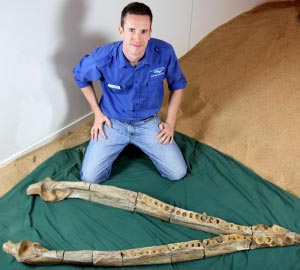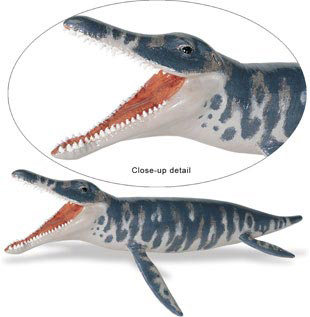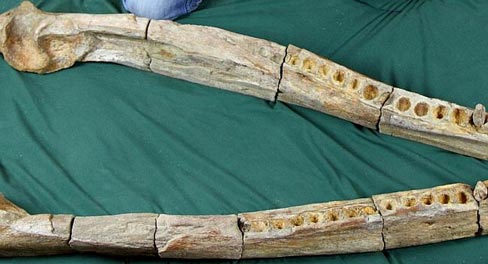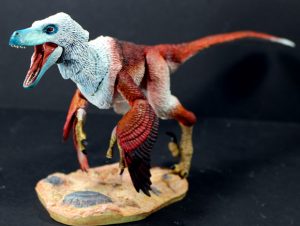Kronosaurus – Down on the Farm
Queensland Farmer Discovers Kronosaurus Jaw Fossil
A Queensland farmer, out spraying weeds on his farm near Nelia in the north-western part of the State, has unearthed the fossilised remains of the lower jaw of a huge marine reptile known as a Kronosaurus. Although the jaw measures 1.6 metres long, it came from a sub-adult, most of the teeth may be missing, but this is one of the best preserved pliosaur jaws found anywhere in the world.
Kronosaurus
Robert Hacon of Euroba Station, was taking advantage of the recent rains that have occurred in this drought hit part of Australia to spray some prickly Acacia plants when he noticed some shiny objects in amongst the weeds. At first, he dismissed them thinking that they were fossilised mussel shells, which are relatively common in this part of the world, evidence to support the idea that much of the land mass we call Australia was part of a warm, tropical, shallow sea back in the Early Cretaceous.
However, curious to find out exactly what the objects were, he returned to the spot a few minutes later and discovered that the recent downpour had exposed a near complete lower jaw bone of a huge marine reptile.
Dr Timothy Holland (Kronosaurus Korner) Poses Next to the Fossil Jaw
Picture credit: Patricia Woodgate
An Apex Marine Predator
The first fossils of this apex, marine predator were discovered in Queensland in 1889. At the time, the fragmentary remains were identified as a type of ichthyosaur, but in 1924 they were reassigned to the short-necked Suborder of the Plesiosauria, the Pliosauroidea.
Most of the fossil material related to the two species of Kronosaurus so far described, have been crushed, severely weathered and distorted, but pliosaurid specialist, Dr Timothy Holland of Kronosaurus Korner, a museum that exhibits a number of marine reptile fossils found in Queensland, stated that this specimen was one of the best found to date.
An Illustration of Kronosaurus (K. queenslandicus)
Picture credit: Everything Dinosaur
The picture above shows a superb model of the marine reptile Kronosaurus (Safari Ltd). This replica is part of the now retired Carnegie Collectibles model series.
To see more prehistoric animals in the Safari Ltd model range: Wild Safari Prehistoric World Models and Figures.
Fossil Donated to the Kronosaurus Korner Museum
The fossilised jawbones have been donated to the Kronosaurus Korner museum, they will shortly be put on display to the public.
Commenting on the fossil find, Dr Holland stated:
“The scary thing is that this creature wasn’t even an adult when it died, it still had a lot of growing to do. We are thrilled to display the specimen, it’s a timely reminder of Australia’s rich geoheritage and I marvel to think what else lies waiting to be found.”
The skull of this ancient marine reptile made up about a quarter of the animal’s entire body length, a spokesperson from Everything Dinosaur commented on the excellent state of preservation and estimated that the total length of the animal would have been approximately seven metres.
A Close up of the Beautifully Preserved Jaw Bones
Picture credit: Patricia Woodgate
Strong Jaws
Posterior parts of the jaw are up to eighteen centimetres thick, indicating that this powerful predator had very strong jaws. It was most likely the top predator in the marine environment, eating fish, cephalopods and other reptiles.
Over the last few years, Everything Dinosaur has reported on a number of marine reptile fossil finds from Queensland, Australia. Some of these fossils turn up in very unexpected places, such as the case of ichthyosaur fossil bones being found in the vegetable patch of a school.
To read more about this amazing discovery: Marine Reptile Fossils Found at School.
In Everything Dinosaur’s fossil and palaeontology predictions for 2015, we predicted that there would be some exciting new dinosaur discoveries reported from Australia. This is certainly an exciting fossil find, but Kronosaurus was not a member of the Dinosauria. Still, more than half of the year to go so we have plenty of time left to be proved right (just for once).
To see the full list of Everything Dinosaur’s predictions: Everything Dinosaur’s Palaeontology and Fossil Predictions for 2015.






